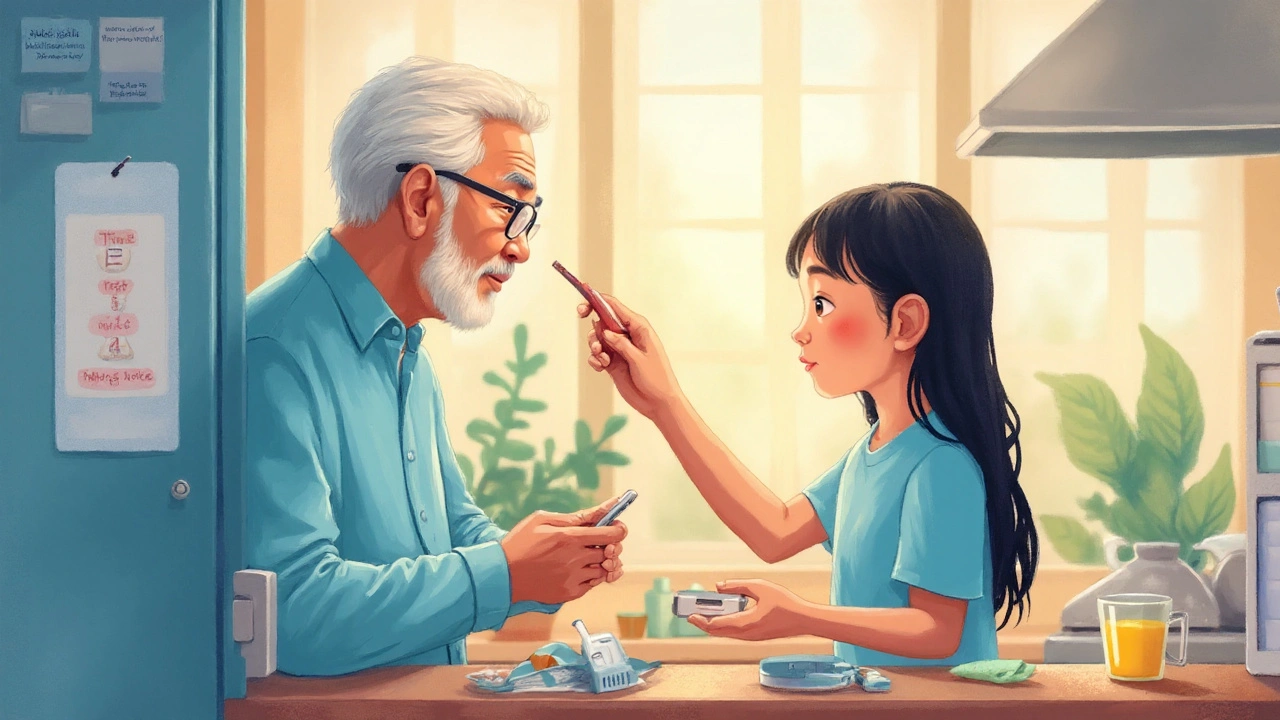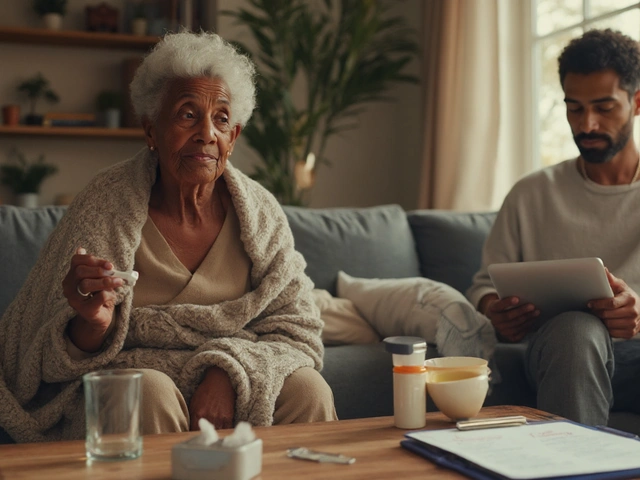If an older adult runs warm, you don’t have time for guesswork. Fever behaves differently later in life-often quieter, sometimes faster to turn serious. This guide shows you how to spot it early, measure it right, treat it safely, and know exactly when to call for help. No fluff-just what works.
TL;DR
- In older adults, fever may be present at 100.0°F (37.8°C), repeated 99.0°F (37.2°C), or a rise ≥2.0°F (1.1°C) above their usual baseline (American Geriatrics Society/IDSA).
- Red flags now: new confusion, trouble breathing, chest pain, low blood pressure, chills with shaking, blue lips, rash with stiff neck, temp ≥103°F (39.4°C), or oxygen drops.
- Big culprits: UTIs, pneumonia, flu/COVID-19, skin infections, abdominal/biliary infections, and sometimes medications or autoimmune issues.
- First steps: recheck temp correctly, hydrate, consider acetaminophen (max 3,000 mg/day for most older adults), track symptoms, and call a clinician if risk factors or symptoms worsen.
- Go to urgent care/ER if red flags show, if fever lasts >48-72 hours, or the person is immunocompromised or on chemo-even with a low fever.
Why Fever Looks Different in Older Adults
Aging lowers the body’s baseline temperature and blunts the immune system’s heat response. That means an older adult may have a serious infection with only a modest temperature bump-or none at all. This muted response is why a small rise from their normal can matter more than in younger people.
Guidelines from the American Geriatrics Society and Infectious Diseases Society of America use a more sensitive definition in this group: oral temperature ≥100.0°F (37.8°C), or repeated readings ≥99.0°F (37.2°C), or an increase of at least 2.0°F (1.1°C) above the person’s established baseline. Long-term care criteria (AMDA/McGeer/Loeb) use similar thresholds to catch infections early.
Why it’s tricky: older adults may show “silent” infection signs-confusion, lethargy, loss of appetite, falls, urinary changes, or faster breathing-before the thermometer screams fever. This is especially true if there’s dementia, stroke history, diabetes, kidney disease, or steroids/chemotherapy in play.
What this means for you: small temperature changes + new behavior changes deserve attention. Waiting for a big spike can waste critical hours.
| Pattern | What it can mean | Typical next move |
|---|---|---|
| 99.0-100.0°F (37.2-37.8°C) or +2°F from baseline | Possible early infection in older adult | Recheck in 1-2 hours; assess symptoms; hydrate; call clinician if new confusion, breathing issues, or high-risk conditions |
| ≥100.0°F (37.8°C) and mild symptoms | Probable infection | Home care + clinician call same day; consider testing (urine, chest, viral) |
| ≥103.0°F (39.4°C) | High fever | Urgent care/ER-especially with comorbidities |
| Any temp + new confusion, RR ≥22, SBP <100, O2 <92% | Potential sepsis/red flag | ER now |
Note: RR = respiratory rate per minute; SBP = systolic blood pressure; O2 = pulse oximeter reading.
What Counts as a Fever and How to Measure It Right
Start with the person’s usual baseline. Many older adults run 97.0-97.5°F (36.1-36.4°C). A rise of 2°F above that can be significant. If you don’t know their baseline, record a week of morning temps during well days for future comparison.
Best tools and technique:
- Digital oral thermometer: reliable if the person can hold it under the tongue properly for the full time indicated.
- Temporal (forehead) scanner: good for quick checks, but confirm any borderline or surprising values with an oral reading.
- Tympanic (ear): decent if used correctly and there’s no earwax or hearing aid in place during measurement.
- Axillary (armpit): least accurate; use only if other sites aren’t possible and confirm if elevated.
How to get a trustworthy reading:
- Wait 15-30 minutes after hot/cold drinks, smoking, or vigorous activity.
- Use the same device and same body site for comparisons.
- Take two readings 5 minutes apart if the number seems off; log the higher one.
- Check at consistent times: morning (when fever may be lowest) and evening (often higher).
When a small number is a big deal:
- If baseline is 97.0°F and they’re at 99.0°F with new confusion or weakness, treat as a fever in this context.
- Low-grade fevers can be more dangerous in someone on chemo, on high-dose steroids, with a transplanted organ, or with an indwelling device (catheter, port, feeding tube).
What professionals look for: Along with temperature, clinicians track pulse, breathing rate, blood pressure, and oxygen saturation. A breathing rate ≥22, SBP <100 mmHg, or a new oxygen drop alarms providers because these can signal sepsis. The Sepsis Alliance and CDC emphasize acting fast when red flags appear.

Common Causes and What the Clues Mean
In older adults, a short list explains a lot of fevers. Here’s how to read the patterns without guessing.
- Urinary tract infection (UTI): Fever or low-grade warmth, burning or urgency (may be absent), suprapubic discomfort, foul-smelling urine. In dementia, look for sudden confusion or falls. Catheters raise risk of serious infection. Hematuria or flank pain suggests kidney involvement.
- Pneumonia or other respiratory infection: Cough, shortness of breath, chest discomfort, faster breathing, drop in oxygen. Older adults may skip the cough and show only fatigue and confusion. Consider aspiration pneumonia if swallowing issues or recent choking episodes.
- Influenza or COVID-19: Fever, aches, sore throat, cough, headache, chills. In 2025, both still circulate seasonally. Antivirals work best within 48 hours of symptom start; call early if the person is high-risk.
- Skin/soft tissue infection (cellulitis): Red, warm, tender skin patch often on legs; may follow a scratch, athlete’s foot, or edema. Rapid spread or streaking needs prompt care.
- Abdominal/biliary infections: Right-upper belly pain after fatty meals (gallbladder), lower-left pain with constipation or diarrhea (diverticulitis). Nausea, bloating, and fever may be subtle in older bodies.
- Medication-related fever: Some drugs can cause fever without infection-antibiotics, anti-seizure meds, and others. Timing matters: fever starts days to weeks after the new med; resolves when stopped.
- Autoimmune/inflammatory: Giant cell arteritis can cause headache, scalp tenderness, jaw pain when chewing, vision changes-treat urgently to prevent blindness. Polymyalgia rheumatica causes shoulder/hip stiffness and low fevers.
- Blood clots and others: Pulmonary embolism can cause low-grade fever with sudden shortness of breath and chest pain. Lymphoma and other cancers sometimes bring persistent low fevers, night sweats, and weight loss.
- Heat-related illness: Hot rooms, poor airflow, or dehydration can drive temperature up. This is not classic infection, but it’s just as risky; cool down and rehydrate quickly.
| Likely cause | Typical clues in older adults | First tests a clinician may order |
|---|---|---|
| UTI | Confusion, urinary changes, lower abdominal discomfort | Urinalysis and culture |
| Pneumonia | Breathing faster, low O2, fatigue more than cough | Chest X-ray, pulse oximetry, CBC |
| Flu/COVID-19 | Aches, cough, fever spikes | Rapid antigen/PCR |
| Cellulitis | Warm, red, tender skin patch | Clinical exam, sometimes ultrasound |
| Abdominal/biliary | Localized belly pain, nausea | Labs (CBC, LFTs), ultrasound or CT |
| Autoimmune | Headache, jaw pain, morning stiffness | ESR/CRP, specific antibodies, temporal artery eval |
Credible sources for patterns and thresholds include the American Geriatrics Society, IDSA, CDC, the National Institute on Aging, and WHO guidance on infection management in older populations.
What To Do Now: Home Care, Meds, and When to Call or Go
Use this simple decision path. It’s built from geriatric and infectious-disease guidance and designed for real homes, not perfect conditions.
Step-by-step:
- Confirm the number. Recheck temp using the same device/site. If forehead reading is borderline, confirm with oral if possible.
- Scan for red flags: new confusion, severe weakness, chest pain, trouble breathing, lips or fingers turning blue, RR ≥22, SBP <100, O2 <92% or a drop >3% from usual, temp ≥103°F, stiff neck with rash, uncontrolled shaking chills.
- If any red flag is present, head to urgent care/ER now or call emergency services.
- If no red flags: start supportive care-fluids, light clothing, rest, and track symptoms.
- Call the person’s clinician the same day if they have cancer/chemo, organ transplant, high-dose steroids, advanced kidney/liver disease, a heart device or catheter, or if fever persists beyond 24 hours without a source.
- Monitor every 4-6 hours: temp, breathing rate, pulse, fluids in, urine out, mental status. Write it down.
Safe symptom relief:
- Acetaminophen: Typical adult dose is 325-650 mg every 4-6 hours as needed. For most older adults, keep under 3,000 mg total per 24 hours. Avoid or lower dose with liver disease, heavy alcohol use, or if taking warfarin-ask a clinician.
- NSAIDs (ibuprofen/naproxen): Use cautiously. They can worsen kidney function, raise blood pressure, and cause bleeding, especially with blood thinners, ulcers, heart failure, or chronic kidney disease. If a clinician okays it, ibuprofen 200-400 mg every 6-8 hours (short term) may help, but many older adults are better off avoiding NSAIDs for fever.
- Non-drug cooling: Remove extra layers, sip cool fluids, use a fan for airflow, and place a cool (not icy) cloth on the forehead or neck. Skip ice baths or alcohol rubs.
Hydration goals: Aim for frequent small sips-water, oral rehydration solution, or broth. If there’s heart failure or kidney disease with fluid limits, check the plan before increasing fluids. Watch for dry mouth, dizziness when standing, or dark urine-early dehydration signals.
When to contact a clinician within 24 hours:
- Temp meets the older-adult fever definition (≥100°F, repeated ≥99°F, or +2°F from baseline) for more than a day.
- New urinary symptoms, wet cough with colored sputum, or a red/warm skin area.
- Fever returns after a short improvement.
- The person just had surgery or a procedure, or has a new catheter or feeding tube.
When to go to urgent care/ER now:
- Any red flag symptoms listed above.
- Suspected sepsis: fever or low temp + fast breathing, fast heart rate, confusion, or very low blood pressure.
- Immunocompromised state (chemo, transplant meds, high-dose steroids), even with low-grade fever.
- Inability to keep fluids down, or very little urine for 8-12 hours.
- Rash with stiff neck or severe headache.
Case snapshot (what “serious” can look like): Your dad, usually sharp, is 97.3°F most mornings. Tonight he’s 99.3°F, breathing 24/min, a bit disoriented. That’s +2°F and RR ≥22. Even though 99.3°F seems mild, those signs meet the “go now” bar for older adults-head to care.
Prevention, Tracking, and Peace-of-Mind Checklists
You can’t control everything, but you can lower the odds and catch trouble early.
Lower the risk:
- Vaccines (as of 2025): Annual influenza vaccine and updated COVID-19 boosters for seniors and caregivers. Pneumococcal vaccine per CDC schedule (PCV20, or PCV15 followed by PPSV23 when indicated). Ask about shingles and RSV vaccines if relevant.
- Hand and oral hygiene: Daily toothbrushing and oral care reduce pneumonia risk in older adults, especially in nursing home settings. Clean hands before meals and after bathroom trips.
- Mobility and breathing: Short walks and incentive spirometry after illness or procedures keep lungs clear. Elevate the head of the bed if reflux or swallowing issues are present.
- Catheter caution: Avoid indwelling urinary catheters unless necessary. Clean technique and timely removal cut UTI risk.
- Food and fluid routines: Regular drinking schedule; protein at each meal; easy-access drinks by the favorite chair.
Build a simple fever plan:
- Baseline sheet: record usual morning body temp for 5-7 well days.
- Red flag card: list the signs that trigger urgent care (confusion, RR ≥22, SBP <100, O2 <92%, chest pain, blue lips, temp ≥103°F).
- Medication grid: acetaminophen dosing window, any NSAID restrictions, and allergy list.
- Contact tree: primary clinician, after-hours nurse line, and a backup driver.
Home grab-and-go kit:
- Digital oral thermometer, spare batteries.
- Pulse oximeter (learn the person’s normal).
- Oral rehydration packets; clean measuring cup; notepad and pen.
- List of meds, doses, and last doses given.
Quick reference: decision rules you can trust
- Treat a +2°F rise from baseline as a fever in an older adult, even if the number looks “low.”
- Confusion + any fever is not “just aging.” It’s a medical symptom until proven otherwise.
- If you’re debating “wait or go,” check breathing rate, blood pressure (if you have a cuff), and oxygen. Abnormal vital signs settle the debate-go.
Checklist: what to track during a fever
- Time and temperature (site and device).
- Fluids in; urine out (note color and frequency).
- Breathing rate for 60 seconds.
- Oxygen saturation, if available.
- Symptoms: cough, pain location, rash, mental status changes.
- Medications given and times.
Mini-FAQ
Do older adults always run a fever with infection? No. Some serious infections show up as confusion, weakness, or rapid breathing without a high temperature.
Can dehydration cause a fever? Mildly, yes. Dehydration can nudge temperature up, especially in warm rooms. Rehydrate and recheck-if fever and symptoms persist, call a clinician.
Will acetaminophen hide an infection? It can lower the number but doesn’t fix the cause. Keep tracking symptoms and talk to a clinician if you’re needing repeated doses.
How long should I watch before calling? If there’s no red flag, a same-day call is wise when fever meets older-adult criteria or you see new urinary, breathing, or skin symptoms. Don’t wait past 24 hours if the source is unclear.
What about antibiotics at home “just in case”? Not recommended without guidance. Wrong antibiotics hide clues, cause side effects, and drive resistance. Testing narrows the target and speeds recovery.
Next steps and troubleshooting by persona
- Family caregiver: Print the red flag card, set the thermometer and oximeter in one basket, and log two baseline temperatures (morning/evening) over the next week.
- Older adult living alone: Place a big-font checklist on the fridge. If you feel “off,” check your temperature and breathing rate, then call your clinician or a trusted contact.
- Post-surgery or chemo patient: Agree on a threshold plan with your team today. Many want a call for any temperature ≥100.0°F or chills, even if numbers are lower.
- Nursing home staff: Follow your facility’s fever protocol (often aligned with Loeb/McGeer criteria). Document baseline, two temps, vitals, mental status, and notify the provider promptly.
Final nudge: infection in late life moves fast and whispers. Trust small changes, measure well, and act early. That’s how you keep a manageable problem from becoming a crisis.
Key source anchors used to shape this guidance: American Geriatrics Society and IDSA fever criteria for older adults; CDC recommendations on sepsis warning signs, influenza, COVID-19, and pneumococcal vaccination; National Institute on Aging resources on infection recognition; and sepsis recognition criteria commonly summarized as fast breathing, low blood pressure, confusion, and oxygen drop. Use local clinical advice to personalize thresholds.
SEO note: If you searched for fever in elderly because you needed a plain-English plan, you now have one-step-by-step, with clear call/ER triggers and safety tips.








